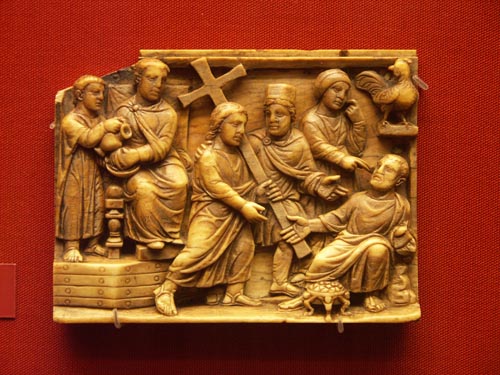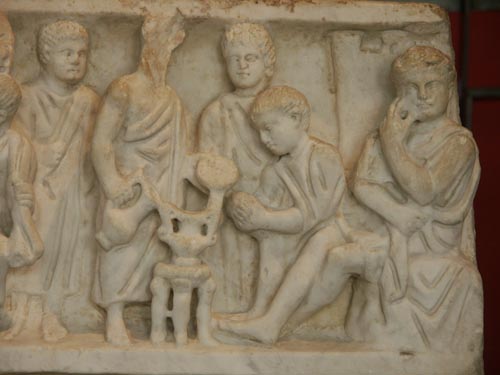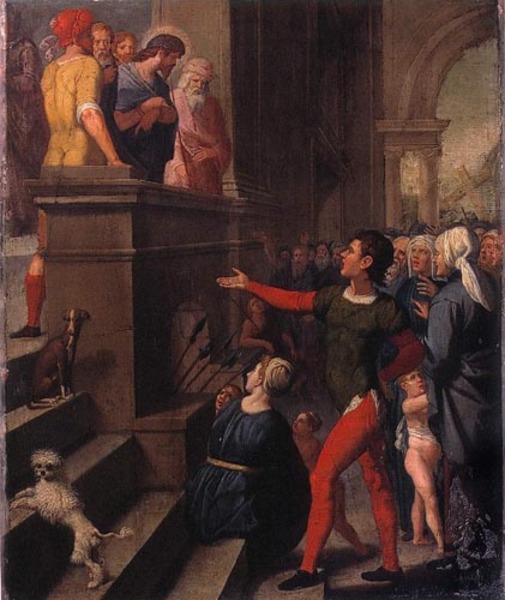He is one of the best known figures in the Bible and also one of the least understood because of the contradictory and ambiguous nature in the textual sources. He is a saint in the Eastern world but is still largely seen as a vacillating and weak character in the Western world. It is clear that our perceptions of him changed over time–mainly in response to religious, social, and racial factors.
Further Reading: Colum Hourihane, Pontius Pilate, Anti-Semitism and The Passion in Medieval Art (Princeton University Press, 2010)
By Colum Hourihane
Director, Index of Christian Art,
Princeton University
October 2010
I can think of very few biblical characters who have suffered as badly as Pontius Pilate with the passing of time. Mythical or historical, good or bad, devious or misunderstood, weak or strong, scapegoat or villain, Roman or Jewish, Christian or Pagan, excusably human or simply a cog in the wheels of pre-destination are just some of the contradictory and ambiguous terms that have been used from the early Christian period to describe this most complex of biblical characters. Despite all the research on Pilate, he still remains an enigmatic figure. Were it not for his pivotal role in the trial and judgment of Jesus Christ, he would have remained an anonymous character, destined for scant historical study. My recent book on Pilate looks at him from textual and historical perspectives against the art of the medieval period –from the fourth to the end of the fifteenth centuries and is the first such survey to look at the Roman administrator and to see how he changed over time.
He is one of the best known figures in the Bible and also one of the least understood because of the contradictory and ambiguous nature in the textual sources. He is a saint in the Eastern world but is still largely seen as a vacillating and weak character in the Western world. It is clear that our perceptions of him changed over time–mainly in response to religious, social, and racial factors. Pilate’s complex nature first appears in the art of the fourth century where he is one of the pivotal and central figures in the sarcophagi (he is also found in other media-metalwork, manuscripts, ivories, etc.). On the sarcophagi, he is given more space than images of Christ, and he always occupies the same position (upper right side of the front face). I believe that in this art he is to be viewed favorably and that these images show him as a Christian. If the apocryphal texts as well as the writing of the Church Fathers are examined, we can see him portrayed as a believer in Christ. My belief is that Pilate’s washing of his hands was not only to absolve him of the sins of condemning Christ but should also be seen as his baptism into the Christian faith. The water baptized as well as cleansed- the water that washes Pilate’s hands is also the water of baptism.

Fig. 1 - Early Christian plaque (one of four) showing Pilate (left side) washing his hands, overlooking Christ Carrying the cross (center), and Peter’s Denial of Christ with the cock crowing (upper right). London, British Museum, ivory, circa 420-30.
From the sixth to the ninth centuries, Pilate was seen as a Christian, but at the start of the tenth century, he gradually becomes aligned with the High Priests-Annas and Caiaphas. It was around this time that we first get images of Pilate on his own with Christ not represented. His character was to suffer badly in the tenth century when he is largely perceived as a Jew. The important question as to who killed Christ and the guilt of the Jews lay at the core of much discussion at this time and this is also at the core of the visualization of Pilate and the trial in this period. The Jews were found guilty of not believing in Christ and so too was Pilate. As he was cast as a Jew at this time, he became a symbol for the Jewish side of that argument. Now, he is indistinguishable from those who were seen at this time as being guilty of killing Christ. He, along with Judas, Annas, Caiaphas, and Herod, are seen as the guilty parties and are treated visually and textually as non-believers. Visually, Pilate takes on all of the negative anti-Jewish qualities that were to stay with him for the rest of the medieval period. He has the hooked nose, dark beard, cross-legged pose, and ostentatious dress that distinguish and separate him from other images of authority. There can be no doubt whatsoever as to how Pilate was to be perceived, especially in the later Middle Ages when images of him are examined. Typical of such works is the Fitzwarin Psalter (Paris, Bibliothèque Nationale, Ms. Lat. 765, f.11r). Here, color is used to denigrate, distinguish, and separate-: in this full-page miniature, the Jews along with Pilate have darkened and gray faces in contrast to Christ whose features are white. Throughout history, there is a definite paradox in representing the trial sequences as visual manifestations of disputational texts in that Pilate is shown as a Jew when in reality he was not. It is compounded also in that he is frequently shown as a king in these images which of course he never was either. In many ways, both of these characteristics complement each other in that they are negative. He cannot be seen as representing good judgment and his personification as a king has to have been as a symbol of bad authority, bad rulership and ill-advised judgment.

Fig. 2 - Pilate judging Christ (detail) from a marble sarcophagus dating to the fourth century. Arles, Musée de l’Arles Antique.
It was at the start of the tenth century that an interest in Pilate developed around his early and later life and written legends were created. What happened to him before and after the trial? How did he die? Where is he buried? These written fabrications paint a negative picture of the procurator, and he is frequently represented as Herod’s son and Judas’ brother! These popular legends fill the gaps in Pilate’s visual life narrative. His youth is particularly interesting and these record that he was the son of a king named Tyrus (variants include Cyrus, or Atus) who seduced a girl named Plya (daughter of a miller called Atus which in some cases is the name given to the king himself), hence, the origins of his name. They show how after the trial he was called back to Rome to answer the emperor, and it is here that the legend of St. Veronica’s sudarium gets subtly interwoven. The document establishes the fact that Pilate was saved from the emperor’s wrath by wearing Christ’s tunic and as such was a believer. His death or suicide gives rise to the many legends of his burial site which extend all over Europe. His final burial place is believed to be Mons Pilatus-a mountain near Lucerne in Switzerland which still carries his name and where it is believed that he can be seen washing his hands every Good Friday . These narratives are essentially what we also find in the thirteenth-century Legenda Aurea of Jacobus Voragine-one of the most popular texts of the entire middle ages.
At the start of the twelfth century when the Law was being codified, the authorities naturally used the trial of Christ before Pilate as the model on which to base their designs. As such, in the twelfth century, Pilate becomes a major symbol of authority, and the Law and his character change yet again. He is now usually shown as a king-with scepter, crown, and orb. Here, there is a visual interplay on the uncrowned king of kings being judged by a symbol of earthly authority with ermine and crown. Pilate represented the Old Law against Christ being the New. Later on his legal role was extended further. He goes from being a symbol of the legal process (albeit a Jewish representative) to a definite personification of evil participation. It is at this stage that he also becomes associated with the devil and evil. Throughout his visual life, Pilate is frequently shown being prompted by a winged devil who stands on his shoulder and speaks into his ear-precisely at the time of judgment and in front of the standing Christ. Pilate’s decision was represented as the decision of the devil. He also participates in the Flagellation as in the St. Alban’s Psalter (he sits to the side with an up-turned flail and is ready to become more actively involved).
We know little of Pilate’s role in Christ’s Passion from the canonical sources apart from the actual trial, but that did not stop the medieval artist from including him in many scenes. Visually, his role was extended way beyond the canonical, and he is present at the crucifixion and also at the Carrying of the Cross as well as at the Nailing to the Cross. All of these extended the negative aspect of his characterization and that of the Jews. Despite the negative press in the medieval period, various efforts were also made to reform his character by theologians such as Anselem of Canterbury and Peter Abelard, who pointed out that if Pilate had not done the will of God the Father and condemned Christ, and then there would not have been Salvation. However, we also have contradictory beliefs of the likes of Bernard of Clairvaux who saw Pilate as guilty and evil.
Throughout his visual career Pilate has also been associated with the dog. There are many images in which a dog sits or growls at Pilate’s feet while Christ stands in front-awaiting sentence. Animals such as the hyena, pig, and scorpion have been used throughout history to symbolize and denigrate Jews. The dog may be added to this list. The association of the dog as one of Christ’s persecutors goes back to the text of Psalm 21, but when associated with Pilate, I believe it also embodies the concept of judgment. It is not uncommon to see blood drip from the dog’s mouth or to see it leap towards Christ to attack him as Pilate was also believed to have done.

Fig. 3 - Ecce Homo by Everard Quirinjz van der Maes with the dog in the foreground. Poitiers, Musée Sainte-Croix, sixteenth century.
At the end of the medieval period, Pilate’s character was still relatively unstable, and despite him being shown visually as a relatively stable, aged, and venerable Jewish administrator and king, he is also shown as the most important figure in the drama of the late medieval period (with more lines than any other character and also from what we can tell the most expensive costumes). In these plays, however, Pilate is a loud, aggressive, and pompous Jewish lord as when he says in the York Cycle (Christ’s Death and Burial Play) - “Prince of gentlest Jews indeed am I.” These two contrasting pictures of the character show how complex he was. I will end this short article as I did the monograph –and that is wondering what Pilate’s original intentions were and in puzzlement as to how they have been interpreted and used for various ends over time. They have meant that he has forever been shrouded in mystery and the Truth may never be known. To use his own words- “Quid est Veritas?”
